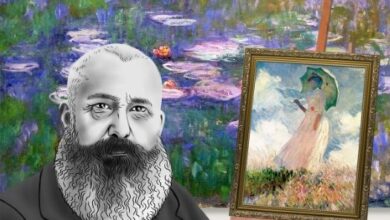
Salvador Dalí is one of the most eccentric, imaginative, and influential artists of the 20th century. Known for his bizarre, dreamlike imagery and mastery of Surrealism, Dalí’s paintings push the boundaries of reality and perception. Born in 1904 in Figueres, Spain, Dalí’s work spans across a wide array of mediums, but it is his paintings that truly captured the surreal world he envisioned. With precise technique and a flair for the absurd, Dalí created an unforgettable legacy in art history, making him a central figure in the Surrealist movement.
The Rise of Surrealism and Dalí’s Role
Surrealism emerged in the 1920s as a response to the horrors of World War I, aiming to express the unconscious mind and challenge traditional norms. Salvador Dalí became a prominent member of this movement, bringing his unique blend of hyper-realism and bizarre symbolism to the forefront. While other Surrealists focused on abstract forms, Dalí combined his technical precision with dreamlike images, creating works that blurred the line between reality and fantasy.
Dalí’s Signature Style
Hyper-Realism and Dreamlike Imagery
One of Dalí’s trademarks was his ability to paint with such precision that his dreamlike subjects appeared almost real. His meticulous attention to detail, coupled with his strange and fantastical imagery, made his paintings both disorienting and mesmerizing. Whether it was melting clocks or elephants with impossibly long legs, Dalí’s hyper-realistic style made the surreal seem tangible.
Incorporation of Symbolism
Dalí’s works are rich with symbolism, often pulling from his personal experiences, subconscious fears, and philosophical influences. His paintings are like puzzles, filled with recurring images such as melting clocks, ants, and distorted human figures. Each element holds deeper meaning, often representing themes of decay, time, and memory.
Dalí’s Early Works
“The Basket of Bread” (1926)
In The Basket of Bread, Dalí demonstrates his early mastery of traditional techniques. This still-life painting is remarkably realistic, showcasing his classical training. Though grounded in realism, this painting foreshadows Dalí’s later exploration of hyper-realism and surreal themes.
“The First Days of Spring” (1929)
The First Days of Spring marks the beginning of Dalí’s surreal period. The painting depicts a dreamlike landscape filled with strange, symbolic imagery. This early work shows his growing interest in psychoanalysis and the subconscious, influenced by Sigmund Freud.
The Importance of “The Persistence of Memory”
Dalí’s The Persistence of Memory (1931) is arguably his most iconic work. The painting, featuring melting clocks draped over a barren landscape, has become synonymous with Surrealism itself.
Melting Clocks and Time’s Fluidity
The melting clocks in The Persistence of Memory symbolize the fluidity and malleability of time, a concept that challenges the rigidity of how time is traditionally understood. The image suggests that time, like memory, is not fixed but instead constantly shifts and changes.
How It Defined Surrealism
This painting encapsulates the core of Surrealism—an exploration of the subconscious mind. The dreamlike quality, bizarre imagery, and rejection of traditional logic made The Persistence of Memory a landmark piece in the movement and solidified Dalí’s reputation as a master of the surreal.
Dalí’s Fascination with Dreams and the Subconscious
Freudian Influence on His Art
Dalí was heavily influenced by the theories of Sigmund Freud, particularly the idea that dreams reveal hidden truths about the subconscious mind. This is evident in many of his works, where dreamlike scenarios unfold with uncanny precision. Dalí believed that by accessing the subconscious, he could create a more profound connection between his art and the human experience.
Dreamlike Elements in His Paintings
From distorted figures to bizarre landscapes, Dalí’s paintings often resemble scenes straight out of a dream. He played with scale, placing tiny figures in vast, open spaces, or creating impossible architectural structures. These dreamlike elements gave his works an otherworldly quality that fascinated viewers.
Exploring Dalí’s Use of Symbolism
Ants, Eggs, and Elephants
Dalí’s paintings are filled with recurring symbols that offer deeper meaning. Ants, for example, often appear in his works as a representation of decay and mortality. Eggs symbolize birth and fertility, while elephants with elongated, spindly legs represent strength and fragility.
The Significance of Clocks and Time
Time is a recurring theme in Dalí’s work, symbolized most famously by his melting clocks. These clocks represent the idea that time is not a rigid, unchangeable force but something fluid and subjective. This theme is also a reflection of Dalí’s personal fears about the passage of time and the inevitability of death.
Dalí’s Religious and Mystical Period
“Christ of Saint John of the Cross” (1951)
In the 1950s, Dalí experienced a shift in his art, moving toward more religious and mystical themes. Christ of Saint John of the Cross is one of the most notable works from this period. The painting depicts Christ on the cross, but from an unusual, almost cinematic perspective, with the viewer looking down from above. This work blends Dalí’s surreal style with a deep sense of spirituality.
The Shift to Spiritual Themes
During this time, Dalí became increasingly interested in religion and science, and this is reflected in his paintings. His later works often depicted biblical scenes, blending surrealism with classical religious imagery in a unique and thought-provoking way.
Dalí’s Relationship with Gala: Muse and Model
Gala’s Influence on His Work
Gala, Dalí’s wife and muse, played a pivotal role in his life and art. She was not only his partner but also his source of inspiration and support. Many of Dalí’s paintings feature Gala as a central figure, often idealized or depicted in surreal scenarios.
Depictions of Gala in Paintings
Dalí’s love for Gala is evident in the way he portrayed her in his paintings. She is often shown as a symbol of stability and strength, grounding the chaotic and surreal elements of his work. Paintings like Galatea of the Spheres reflect his adoration for her, where she is portrayed as a divine figure in a cosmic, otherworldly environment.
Dalí’s Later Years and His Move Towards Classical Painting
In his later years, Dalí’s style shifted again, this time toward a more classical approach. He began to incorporate more traditional techniques and subjects, such as religious scenes, but he never abandoned his surrealistic roots. This period of his life was marked by a blending of the old and the new, as he sought to bridge his earlier experimental works with a more refined, technical approach.
Dalí’s Legacy in Modern Art
Influence on Pop Culture and Modern Artists
Dalí’s influence extends far beyond the realm of fine art. His surreal imagery has permeated popular culture, influencing everything from fashion to film. Modern artists continue to draw inspiration from his bold use of symbolism, his embrace of the absurd, and his mastery of technique.
Dalí in Museums and Popular Culture
Dalí’s works are displayed in museums around the world, including the Salvador Dalí Museum in Florida and the Dalí Theatre-Museum in Figueres, Spain. His eccentric persona and groundbreaking art continue to captivate audiences, keeping his legacy alive in both the art world and popular culture.
Dalí’s Use of Color and Light
Dalí’s use of color was striking, often using vibrant hues against darker backgrounds to create contrast and depth. His lighting was dramatic, with strong shadows that emphasized the dreamlike quality of his paintings, lending an almost theatrical feel to his work.
Criticism and Controversy: Dalí’s Public Persona
His Eccentricity and How It Affected His Reputation
Dalí’s eccentric public persona—marked by his flamboyant mustache, outrageous statements, and bizarre behavior—sometimes overshadowed his art. While this made him a celebrity, it also drew criticism from those who felt his antics undermined his talent. Yet, Dalí believed that his eccentricity was a key part of his genius.
Dalí’s Techniques: Meticulous Precision and Surrealism
Dalí’s technique combined classical painting methods with surreal subject matter. His works are known for their precise, almost photographic detail, which contrasts with the strange, dreamlike scenes they depict. He often layered reality with fantasy, creating a sense of disorientation that is characteristic of Surrealism.
Dalí’s Contributions Beyond Painting: Sculpture, Film, and Design
Dalí’s creativity was not limited to painting. He explored various mediums, including sculpture, film, and even product design. He collaborated with filmmakers like Alfred Hitchcock and Walt Disney, creating iconic works that bridged the gap between fine art and popular media.
Conclusion
Salvador Dalí’s paintings continue to intrigue and inspire viewers around the world. His surreal, dreamlike visions, combined with his technical mastery, left a profound mark on the art world. Dalí’s ability to fuse reality and fantasy challenged conventional notions of art and continues to influence artists today. From his melting clocks to his religious iconography, Dalí’s work remains timeless, transcending the boundaries of Surrealism and becoming an integral part of modern culture.
FAQs About Salvador Dalí and His Paintings
- What is Salvador Dalí’s most famous painting?
Dalí’s The Persistence of Memory (1931), featuring melting clocks, is his most iconic painting and a defining work of the Surrealist movement. - What influenced Salvador Dalí’s art?
Dalí was influenced by the theories of Sigmund Freud, particularly in exploring the subconscious mind and dreams. He was also inspired by science, religion, and his relationship with his wife, Gala. - Why are clocks melting in Dalí’s paintings?
The melting clocks in Dalí’s paintings symbolize the fluidity and relativity of time, challenging traditional concepts of its rigidity. - Where can I see Salvador Dalí’s paintings?
Dalí’s works are featured in major museums around the world, including the Dalí Theatre-Museum in Spain and the Salvador Dalí Museum in Florida.
Was Salvador Dalí involved in other forms of art?
Yes, beyond painting, Dalí was involved in sculpture, film, fashion, and design, collaborating with filmmakers like Alfred Hitchcock and Walt Disney to create iconic pieces.


